By any standard, 2020 wasn’t the best year. We won’t repeat the litany of misfortunes that befell so many people, and instead note that each new disaster often brought out the best in humanity. Here we list just a few examples, which we hope to see more of in 2021.
Billions of people fight back against a global pandemic
Never in human history has news of a pandemic raced so far ahead of infections, as a result of today’s communications technology. After a period of confusion and conflicting recommendations, researchers, health care providers, and ordinary people began to rally against COVID-19. As scientists raced to discover causes, symptoms, treatments, and vaccines, doctors and nurses put their lives on the line to keep death rates as low as possible. Meanwhile, ordinary people learned what they could about how to protect themselves and others. Around the world, they adopted simple measures like wearing a mask and physical distancing to slow the spread of the disease. Discover why your sacrifices matter during the pandemic.
Quarantined residents sing from their balconies
Amid a lockdown in March, Italians across the country took to their balconies to sing together, closing the distance between them with music. Communal singing also brought people together in Lebanon and Israel. Over in Spain, people in one apartment complex even joined together for a group fitness class at a distance, squatting and doing jumping jacks from their balconies. Discover how music brings us together.
Chinese medical staff bring supplies to help Italy
In March, Italy was the worst-hit country in the world. Medical experts from China landed in Rome with a supply of masks, respirators, and other supplies to help fight COVID-19. The flight was organized by the Chinese Red Cross and brought around 30 tons of equipment to Italy. Find out what the pandemic can teach kids about compassion.
People self-organized to help those in need

Grassroots groups sprung up where people can offer and ask for help from their neighbors. This list includes groups by state in the U.S., as well as several in Canada, Britain, and Germany. Utah resident Suzette Aposhian collected knitted hats and scarves for people who needed them in the winter. In Toronto, people gave away food, offered to foster animals, and picked up medication for others. In the U.K., a woman designed a postcard (above) that you can drop off with neighbors who are self-isolating, offering your help with shopping or a friendly phone call. Read about how one woman found purpose and connection in the pandemic.
NBA players chipped in to pay arena workers while games are cancelled
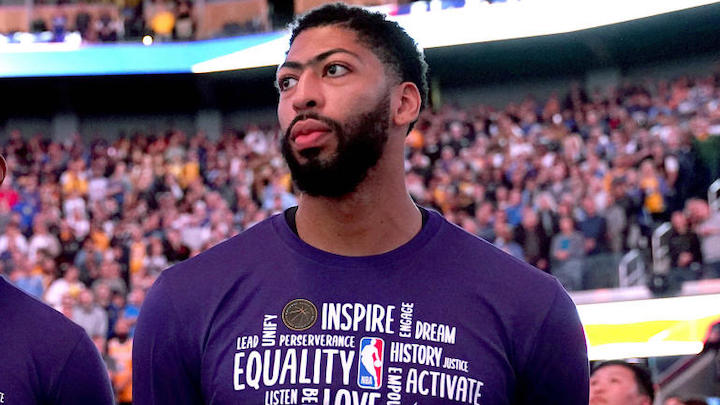 Lakers star forward Anthony Davis announced a partnership with Lineage Logistics that helped Staples Center workers find work while the NBA is suspended. Davis and Lineage also matched up to $250,000 in donations for Feed the Frontlines LA, an organization that is aiming to raise money to purchase food from local restaurants to deliver it to hospital workers.NBA games were suspended for much of the year, which meant no work for arena employees like ticket takers, food vendors, and performers. But at some arenas, players and team owners donated hundreds of thousands of dollars to make up their wages. Learn how helping others can help you during the pandemic.
Lakers star forward Anthony Davis announced a partnership with Lineage Logistics that helped Staples Center workers find work while the NBA is suspended. Davis and Lineage also matched up to $250,000 in donations for Feed the Frontlines LA, an organization that is aiming to raise money to purchase food from local restaurants to deliver it to hospital workers.NBA games were suspended for much of the year, which meant no work for arena employees like ticket takers, food vendors, and performers. But at some arenas, players and team owners donated hundreds of thousands of dollars to make up their wages. Learn how helping others can help you during the pandemic.
Pet adoptions skyrocketed amid crisis
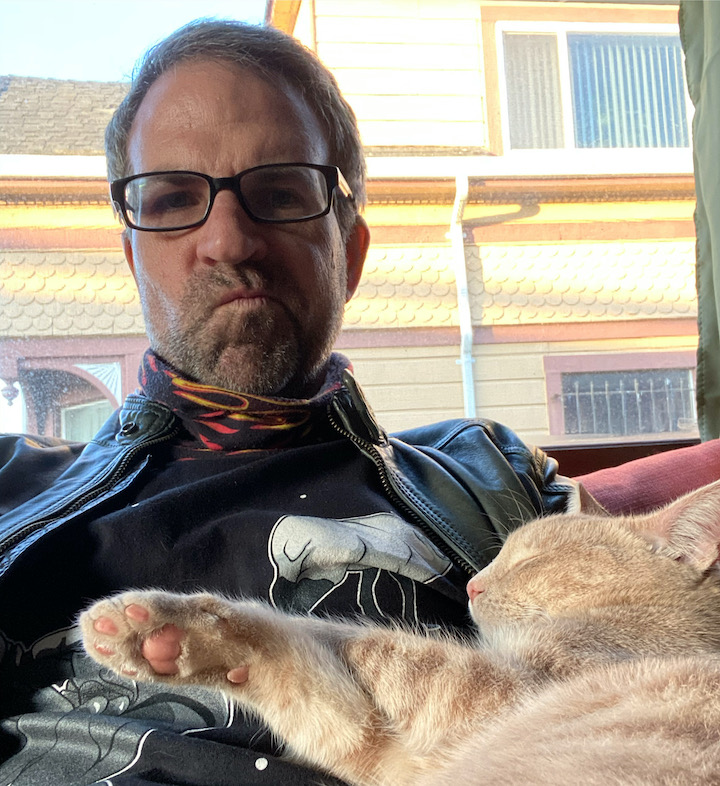 Greater Good editor Jeremy Adam Smith reluctantly adopted two cats during shelter-in-place—and he reports that they have made him very happy, mostly.Stuck at home, Americans instinctively looked for someone to care for—and so started adopting cats, dogs, and other pets in record numbers. America’s animal shelters came up with creative ways to stay open in the crisis, pairing people and pets. “People stepped up in a huge way,” says Angela Speed, vice president for communications for the Wisconsin Humane Society. “We all recognize that animals are a source of comfort, love, and stress reduction in a chaotic, unprecedented time.” Learn about the benefits of having a pet during lockdown.
Greater Good editor Jeremy Adam Smith reluctantly adopted two cats during shelter-in-place—and he reports that they have made him very happy, mostly.Stuck at home, Americans instinctively looked for someone to care for—and so started adopting cats, dogs, and other pets in record numbers. America’s animal shelters came up with creative ways to stay open in the crisis, pairing people and pets. “People stepped up in a huge way,” says Angela Speed, vice president for communications for the Wisconsin Humane Society. “We all recognize that animals are a source of comfort, love, and stress reduction in a chaotic, unprecedented time.” Learn about the benefits of having a pet during lockdown.
Black Lives Matter demonstrator carries a counter-protester to safety
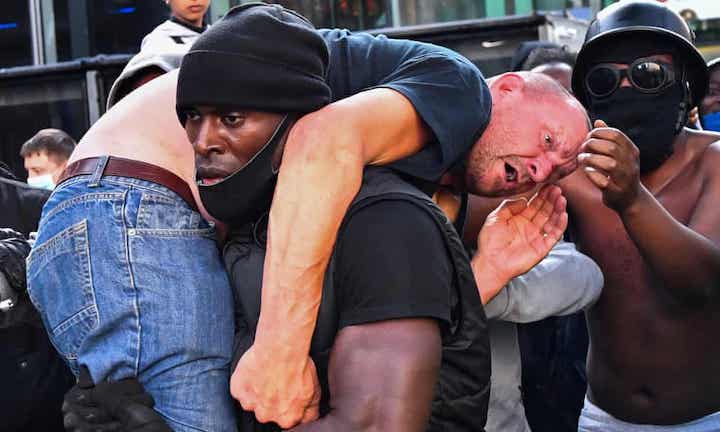 Patrick Hutchinson carries an injured man near Waterloo station in London. Photograph by Dylan Martinez/Reuters.
Patrick Hutchinson carries an injured man near Waterloo station in London. Photograph by Dylan Martinez/Reuters.
In June, a London protest against the police killing of George Floyd in Minneapolis drew aggressive counter-demonstrators, many of whom shouted openly white supremacist slogans. When the confrontation turned violent, personal trainer (and grandfather) Patrick Hutchinson scooped up an injured far-right counter-protester and carried him to safety. The photo of the incident went viral. Later, Hutchinson told British media:
If the other three police officers that were standing around when George Floyd was murdered had thought about intervening, and stopping their colleague from doing what he was doing, like we did, George Floyd would be alive today. I just want equality, equality for all of us. At the moment, the scales are unfairly balanced and I just want things to be fair for my children and my grandchildren.
Learn how to stand up for what’s right, even when you’re afraid.
NASCAR bans Confederate flag
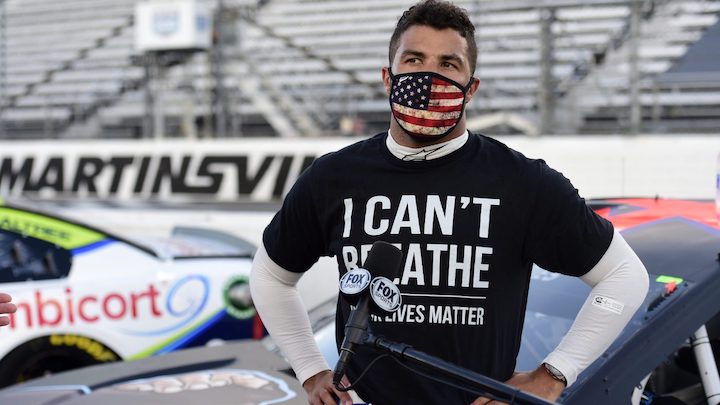 Bubba Wallace wears a “I Can’t Breathe/Black Lives Matter” T-shirt under his fire suit in solidarity with protesters around the world taking to the streets after the death of George Floyd on May 25. Jared C. Tilton/Getty ImagesIn June, the National Association for Stock Car Auto Racing (NASCAR) stunned the sports world with this announcement:
Bubba Wallace wears a “I Can’t Breathe/Black Lives Matter” T-shirt under his fire suit in solidarity with protesters around the world taking to the streets after the death of George Floyd on May 25. Jared C. Tilton/Getty ImagesIn June, the National Association for Stock Car Auto Racing (NASCAR) stunned the sports world with this announcement:
The presence of the Confederate flag at NASCAR events runs contrary to our commitment to providing a welcoming and inclusive environment for all fans, our competitors, and our industry. Bringing people together around a love for racing and the community that it creates is what makes our fans and sport special. The display of the confederate flag will be prohibited from all NASCAR events and properties.
It was a statement that drew immediate backlash from many racing fans, but NASCAR stood firm in its stand against a heritage of hate. Discover what Confederate flags reveal about American psychology.
The honoring of Ruth Bader Ginsburg
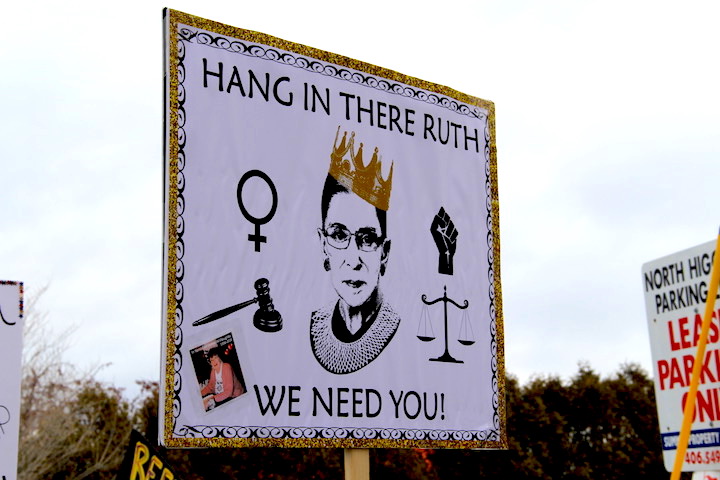 A poster depicting Supreme Court Justice Ruth Bader Ginsburg in the likeness of American rapper The Notorious B.I.G., 2018If Joan Ruth Bader Ginsburg had never joined the Supreme Court of the United States, she still would have been honored for her legal career as an advocate for gender equality and women’s rights. As an associate justice of the Supreme Court, however, she became a cultural phenomenon. Her death on September 18, 2020, provoked an outpouring of grief that highlighted the qualities she exemplified: intelligence, courage, curiosity, empathy, compassionate anger, fairness, and perseverance, among others. RBG will be remembered as a woman worth emulating. Explore how women can use their anger for good.
A poster depicting Supreme Court Justice Ruth Bader Ginsburg in the likeness of American rapper The Notorious B.I.G., 2018If Joan Ruth Bader Ginsburg had never joined the Supreme Court of the United States, she still would have been honored for her legal career as an advocate for gender equality and women’s rights. As an associate justice of the Supreme Court, however, she became a cultural phenomenon. Her death on September 18, 2020, provoked an outpouring of grief that highlighted the qualities she exemplified: intelligence, courage, curiosity, empathy, compassionate anger, fairness, and perseverance, among others. RBG will be remembered as a woman worth emulating. Explore how women can use their anger for good.
Competing gubernatorial candidates try to bring voters together
In a profoundly polarized political season, Spencer Cox and Chris Peterson decided to try bridge divides, instead of widen them. In a joint ad, the Republican and Democratic candidates for governor of Utah pleaded for voters to find common ground. “We can debate issues without degrading each other’s character,” said one. “We can disagree without hating each other,” said the other. Learn how humility can help bridge our divides.
More people voted in the American presidential election than ever before, despite barriers
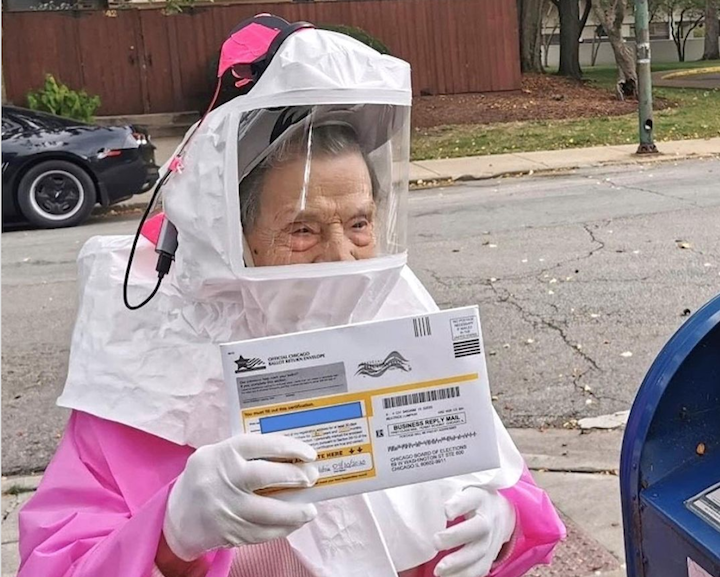 102-year-old Chicago resident Beatrice Lumpkin (who was born before women had the right to vote) donned a hazmat suit designed by her grandson to mail her ballot last month amid the pandemic. From Bea Lumpkin’s Facebook page.In the face of COVID-19 and the threat of political violence, more Americans turned out to vote in the presidential election than ever before—and at the highest rate since 1900. It was an inspiring exercise in democracy that resulted in the election of Joe Biden as president and Kamala Harris as the first Black woman vice president. Learn about how equality encourages voting.
102-year-old Chicago resident Beatrice Lumpkin (who was born before women had the right to vote) donned a hazmat suit designed by her grandson to mail her ballot last month amid the pandemic. From Bea Lumpkin’s Facebook page.In the face of COVID-19 and the threat of political violence, more Americans turned out to vote in the presidential election than ever before—and at the highest rate since 1900. It was an inspiring exercise in democracy that resulted in the election of Joe Biden as president and Kamala Harris as the first Black woman vice president. Learn about how equality encourages voting.
Harvard professor teaches Elon Musk a master class on emotional intelligence
@elonmusk - My quick answers to your question are above. I think you'd be interested in the detailed answer. Send me a DM if you want. You're a scientist and it would be GREAT if you could help inform the world of the right answer to your question - So much confusion abounds.
— Michael Mina (@michaelmina_lab) November 15, 2020
When billionaire Elon Musk expressed frustration on Twitter over testing for COVID-19, Harvard immunologist and physician Michael Mina responded. As Inc. Magazine describes, Mina began his reply on notes of positivity—“Great question”—and respect—“You’re a scientist.” He followed that by:
- Getting into the nuances of Musk’s inquiry
- Presenting alternative scenarios, directly answering Musk’s question in the light of each one
- Offering to send Musk a more detailed answer via direct message
- Attempting to motivate Musk to act
Musk retweeted Mina’s answers, sharing them with his audience of millions. During a time when health information has been unfortunately politicized, the exchange stood out as an example more of us should follow. Learn how to encourage safe behavior during the pandemic.
The creation and distribution of vaccines for COVID-19
.jpg) Army Captain Isaiah Horton, a doctor at Walter Reed National Military Medical Center, receives a COVID-19 vaccination in Bethesda, Md., on Dec. 14, 2020. Department of Defense photo by Lisa Ferdinando. As soon as COVID-19 appeared in Wuhan, China, governments and corporations around the world mobilized their resources to create a vaccine. Private individuals like the country-music star Dolly Parton donated millions to vaccine research. Within a year, we had multiple vaccines—and the health care providers who had been saving lives throughout the pandemic were the first to roll up their sleeves. Discover 11 questions to ask about COVID-19 research.
Army Captain Isaiah Horton, a doctor at Walter Reed National Military Medical Center, receives a COVID-19 vaccination in Bethesda, Md., on Dec. 14, 2020. Department of Defense photo by Lisa Ferdinando. As soon as COVID-19 appeared in Wuhan, China, governments and corporations around the world mobilized their resources to create a vaccine. Private individuals like the country-music star Dolly Parton donated millions to vaccine research. Within a year, we had multiple vaccines—and the health care providers who had been saving lives throughout the pandemic were the first to roll up their sleeves. Discover 11 questions to ask about COVID-19 research.








Comments